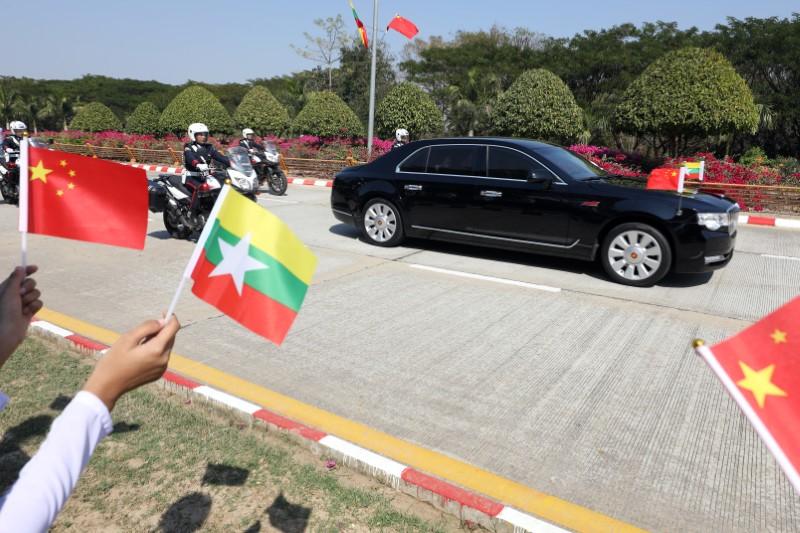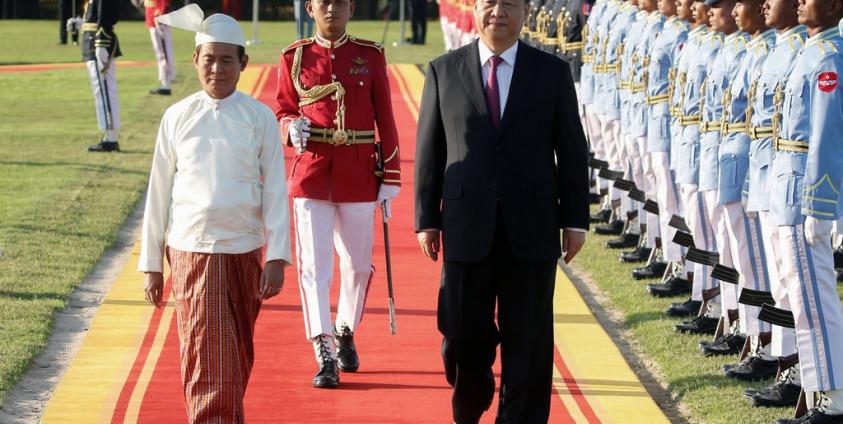Sai Wansai — China’s President Xi Jinping’s two-day Myanmar visit from 17 to 18 is remarkable in a sense of heightening bilateral relationship concerning the Belt and Road Initiative (BRI), although no “big bang” sort of agreement as speculated has been reached.
However, the bilateral relationship could be seen as stable and even deepening as the State Counselor Aung San Suu Kyi and the Chinese president witnessed the 33 exchange of the agreements, memorandum of understanding (MOU) and documents between Myanmar and China.
“Both sides agreed to step up BRI cooperation and promote the three pillars of the China-Myanmar Economic Corridor (CMEC), namely the Kyauk Phyu Special Economic Zone, Myanmar-China Border Economic Cooperation Zones, and new urban development of Yangon City as well as framework infrastructure projects of connectivity such as roads, railways, electric power and energy. Both sides agreed to designate the year 2020 as “Myanmar-China Year of Culture and Tourism””, according to the Myanmar Ministry of Foreign Affairs announcement, on 18 January 2020.
The said announcement wrote: “The Chinese side supports the efforts of the Myanmar side to advance the national reconciliation and peace process through political dialogue based on the spirit of Panglong Conference. The Myanmar side appreciates the positive and constructive support extended by the Chinese side to the process.”
In addition: “The Chinese side also supports the efforts of Myanmar to address the humanitarian situation, and to promote peace, stability and development for all communities in Rakhine State. Myanmar reiterated its commitment to receive verified displaced persons based on the bilateral agreement reached between Myanmar and Bangladesh. Myanmar thanked China for its understanding of the complexity of the issue and for all its support to Myanmar.”
Surprisingly, the controversial Myitsone Dam project was not mentioned during the two-day Chinese president visit.
Concerning the Chinese president visit, opinions differed quite a lot between the ethnic armed organizations (EAOs), that haven’t sign the nationwide ceasefire agreement (NCA) with the government based on the opposite side of the China border in northern Shan State, and the non-Bamar ethnic civil society organizations (CSOs) from Kachin, Shan and Arakan (Rakhine) states, including various ethnic political parties (EPPs).
All four members of the rebel Northern Alliance-Burma (NA-B), the Arakan Army (AA), Kachin Independence Army (KIA), Myanmar National Democratic Alliance Army (MNDAA), and Ta’ang National Liberation Army (TNLA) — which are in armed conflict with the government troops in Arakan, Kachin, and northern Shan states, issued statements welcoming Chinese president’s visit.
All supported the BRI, although Kachin Independence Organization (KIO), political wing of the KIA, in its statement didn’t mention the BRI projects, emphasized that bilateral agreements might help settle Kachin state’s civil war and boost security in unstable border areas. The KIO statement also made suggested appeal that President Xi should take into consideration the diverse opinions of different ethnic groups and organizations, including lending them necessary passionate support.
But the KIA didn’t mention the controversial Myitsone Dam project in its statement and the AA also failed to give any opinion on Kyauk Phyu Special Economic Zone, which is one of the three main pillars of BRI cooperation between the China and Myanmar.
The opinion of AA, TNLA and the United Wa State Army (UWSA), the strongest with some 30,000 troopers, in their statements readily agreed that BRI projects and the CMEC would benefit the ethnic local people. The UWSA even stated in its statement that the BRI projects would improve Myanmar’s outdated economy, trade, and infrastructure.
Moreover, the UWSA indicated that the northern Myanmar peace process problem is linked to the development of Myanmar-China and people to people bilateral relationships. In this respect the UWSA is determined to strive for appropriate, effective, practical, political solution to resolve the northern Myanmar peace process problematic, according to its statement.
TNLA spokesman Colonel Mai Aik Kyaw hoped that the BRI projects would be successful and benefit the people.
He reasoned his endorsement saying: “Mainly, the BRI projects that cuts through northern Shan if successful will benefit the local people. I see it like this.”
“The main thing is the people have to really benefit from it. Those who are negatively affected would have to be justly compensated. My view is China cannot be responsible on such matters and it is solely the burden of the (Myanmar) government,” he added.
Meanwhile, the Kachin, Shan and Arakan CSOs issued statements of their own calling on President Xi to stop the BRI projects in their respective areas.
Likewise, the Shan Nationalities League for Democracy (SNLD) also released a statement on China-Myanmar economic cooperation in general, pointing out the likelihood of more conflict if project implementations were to be carried out by the central government without the consent of the local people and concerned ethnic state parliaments.
SNLD spokesman Sai Leik said as the implementation are closely linked to the land use and likelihood of land confiscation for planned BRI projects, problems and conflicts are bound to happen.
“If high-speed rail including motor road will be built from northern Shan to Mandalay, all land along the planned road network will be confiscated. Nobody could be certain regarding the land confiscation, the local people might find themselves in trouble under the new law on vacant land [Vacant, Fallow and Virgin Land Management Law (VFV Land Law)],” he explained.
“These are the concerns and problems that the people might be facing tomorrow and they are glaring examples”
In the same vein, on January 16, the United Nationalities Alliance, which has some 15 EPPs as members, issued a five-point statement on how environmental and societal sustenance could be achieved concerning investment and project implementation.

Myanmar students hold Myanmar and Chinese flags as they welcome Chinese President Xi Jinping outside of the airport in Naypyitaw, Myanmar, January 17, 2020. REUTERS/Ann Wang
They are: affirmative consent of the people; regarding union-wide projects securing people’s inputs, transparency and including wide public awareness distribution; without agreement from the local people no project is to be undertaken; only after environmentally challenged solutions and mechanism are in place, should the project be accepted and implemented; and opinions of concerned political parties, local organizations and people in feasibility, confirmation, field studies and trials have to be sought.
Taken into account of the unfolding scenarios before and the aftermath of the Chinese president visit, the questions arise as to why the EAOs readily endorsed the BRI, without much questions, but the CSOs and the EPPs roundly rejected it.
The answer is simple enough. The EAOs that have not yet sign the NCA are stationed along the China border and all have to rely on China from provisions, ammunition to armament and not to mention the political support in the deliberation of peace talks with the Myanmar government. Thus, it is not a wonder that they have to welcome the BRI and fall in line with the regional power, which now is fast becoming a super power.
The CSOs and the EPPs on the other hand are locally based and who know first hand the grievances of the population. Apart from that the central union government calling the shots without the ethnic states population’s consent and non-participation in decision-making process in mega and minor economics and infrastructure projects alike, are hardly in line with the aspirations of a federal union.
All in all, the 33 MOU signed are not a contract as yet. And as such a lot of alteration and changes will definitely take place in the aftermath of the 2020 national elections.
Meanwhile, China will just have to be satisfied with the launching of Myanmar-China Culture and Tourism Year 2020 to celebrate the 70th Anniversary of the Establishment of Myanmar-China Diplomatic Relations.
Who knows, “the promotion of people-to-people exchanges and closer collaboration and coordination in both regional and multilateral fora on issues of mutual interest” will bring positive outcomes, rather than just only negative rejection from ethnic population, who mostly are saddled with the BRI mega projects.
<><><>
Captions :
0001
President Xi Jinping of China and his counterpart in Myanmar, Win Myint, during a welcome ceremony at the Presidential Palace in Naypyidaw, Myanmar, on Friday.Credit…Ann Wang/Reuters
0002
Myanmar students hold Myanmar and Chinese flags as they welcome Chinese President Xi Jinping outside of the airport in Naypyitaw, Myanmar, January 17, 2020. REUTERS/Ann Wang







